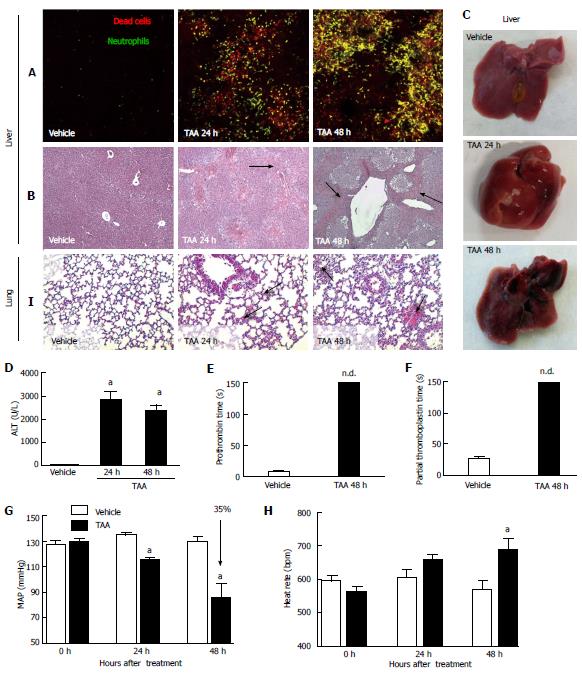Copyright
©2014 Baishideng Publishing Group Co.
World J Hepatol. Apr 27, 2014; 6(4): 243-250
Published online Apr 27, 2014. doi: 10.4254/wjh.v6.i4.243
Published online Apr 27, 2014. doi: 10.4254/wjh.v6.i4.243
Figure 2 Thioacetamide caused severe liver necrosis and inflammation, which may explain mice metabolic encephalopathy, coagulopathy and remote lung injury.
A: Liver intravital microscopy showing crescent number of necrotic cells (in red, propidium iodide) with concomitant neutrophil infiltration (in green, Lysm-eGFP mice); B: Liver sections stained by hematoxylin and eosin (4 × increase). Arrows indicate necrotic areas; C, D: Liver macroscopic analysis confirmed extensive and diffuse necrosis, which is also reflected by elevated serum transaminase activity (D); E, F: Liver failure was confirmed by prolonged prothrombin and partial thromboplastin times; G, H: Also, significant drop in mean arterial pressure (MAP; G) and increased heart rate (H), as assessed by tail cuff method, suggested that TAA-treated mice also evolved to hemodynamic shock; I: After TAA treatment hours, lungs from mice had increased cellularity in lung parenchyma, alveolar edema and hemorrhage in comparison to controls (arrows, 4 x increase) aIndicates statistical significance in comparison to controls. aP < 0.05, ANOVA (Tukey’s post test). N ≥ 5 for each group. TAA: Thioacetamide.
- Citation: Gomides LF, Marques PE, Faleiros BE, Pereira RV, Amaral SS, Lage TR, Resende GHS, Guidine PAM, Foureaux G, Ribeiro FM, Martins FP, Fontes MAP, Ferreira AJ, Russo RC, Teixeira MM, Moraes MF, Teixeira AL, Menezes GB. Murine model to study brain, behavior and immunity during hepatic encephalopathy. World J Hepatol 2014; 6(4): 243-250
- URL: https://www.wjgnet.com/1948-5182/full/v6/i4/243.htm
- DOI: https://dx.doi.org/10.4254/wjh.v6.i4.243









